Problem Description
Nash Equilibrium is an important concept in game theory. Rikka and Yuta are playing a simple matrix game. At the beginning of the game, Rikka shows an $$$n imes m$$$ integer matrix A. And then Yuta needs to choose an integer in $$$[1,n]$$$, Rikka needs to choose an integer in $$$[1,m]$$$. Let $$$i$$$ be Yuta's number and $$$j$$$ be Rikka's number, the final score of the game is $$$A_{i,j}$$$. In the remaining part of this statement, we use $$$(i,j)$$$ to denote the strategy of Yuta and Rikka. For example, when $$$n=m=3$$$ and matrix $$$A$$$ is $$$$$$ egin{bmatrix} 1 & 1 & 1 \ 2 & 4 & 1 \ 1 & 3 & 1 \ end{bmatrix} $$$$$$ If the strategy is $$$(1,2)$$$, the score will be $$$2$$$; if the strategy is $$$(2,2)$$$, the score will be $$$4$$$. A pure strategy Nash equilibrium of this game is a strategy $$$(x,y)$$$ which satisfies neither Rikka nor Yuta can make the score higher by changing his(her) strategy unilaterally. Formally, $$$(x,y)$$$ is a Nash equilibrium if and only if: $$$$$$egin{cases} A_{x,y}≥A_{i,y}, & {forall i in [1,n]} \[1ex] A_{x,y}≥A_{x,j}, & {forall j in [1,m]} end{cases}$$$$$$ In the previous example, there are two pure strategy Nash equilibriums: $$$(3,1)$$$ and $$$(2,2)$$$. To make the game more interesting, Rikka wants to construct a matrix $$$A$$$ for this game which satisfies the following conditions: 1. Each integer in $$$[1,nm]$$$ occurs exactly once in $$$A$$$. 2. The game has at most one pure strategy Nash equilibriums. Now, Rikka wants you to count the number of matrixes with size $$$n×m$$$ which satisfy the conditions.
Input
The first line contains a single integer $$$t(1≤t≤20)$$$, the number of the testcases.
The first line of each testcase contains three numbers $$$n$$$,$$$m$$$ and $$$K$$$ $$$(1≤n,m≤80,1≤K≤10^9)$$$.
The input guarantees that there are at most $$$3$$$ testcases with max$$$(n,m)>50$$$.
The first line of each testcase contains three numbers $$$n$$$,$$$m$$$ and $$$K$$$ $$$(1≤n,m≤80,1≤K≤10^9)$$$.
The input guarantees that there are at most $$$3$$$ testcases with max$$$(n,m)>50$$$.
Output
For each testcase, output a single line with a single number: the answer modulo K.
Sample Input
2
3 3 100
5 5 2333
3 3 100
5 5 2333
Sample Output
64
1170
1170
题意
求符合条件的n*m的矩阵的个数,要求1~n*m每个数只用一次,且只能有一个位置满足同时是所在行和列最大的数
分析
最大的数是n*m,它比所有数都大,所以n*m永远是它所在行和列最大的数,同时也因为它一定是最大的,所以它的安放不受任何限制。
假设已经给n*m安排了一个位置,那么n*m-1就是剩下的数中最大的,但是他的安放收到限制,不能再让他同时满足行列最大。观察发现,它只有在n*m同行或同列时,它才不是这行或这一列最大的,也就是说n*m-1必须和n*m同行或同列。接下来n*m-2也是同理,必须和n*m或n*m-1其中一个同行或同列。
因此,为了构造合法的矩阵,优先考虑的是当前最大的数,所以应该按照从大到小的顺序来填充。只要保证每个数都与之前的数中的某一个同行同列,那么构造出来的所有矩阵都是合法的。
如果换个角度来看问题就是这样,每次操作都有若干个位置可以选择,而每次给一个数安排一个位置,就相当于把所在的行和列,加入到下一个数的可选位置中。
容易发现,如果选择的位置所在行已经被添加过,那么可选位置只会增加列;如果所在列已经被添加过,那么只增加行;如果都被添加过了,那么这次安排就不会产生新的位置。根据增加的情况不同,可以把矩形划分成若干个区域,在某个区域中的任意位置安放数,增加的个数都是相同的。 为了方便分析,因为在同一区域中安放对最后求方案个数没有影响,可以规定每次只能选择区域左上角的位置。
比如说,第一个数有n*m种选择,但只考虑把它放到(1,1),然后把第一行和第一列加入到可选择的位置;
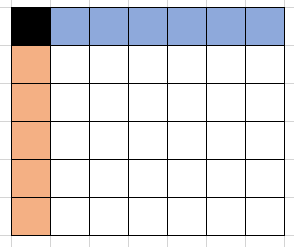
第二个数有n+m-1种选择,它可以放到与(1,1)相邻的(1,2),或(2,1)
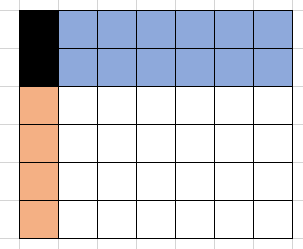 或
或 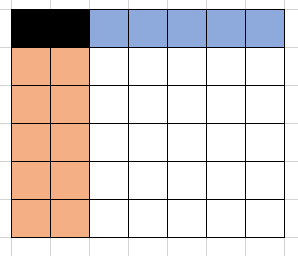
后面的数以此类推

比较一般的情况:

接下来的问题就是,需要维护的只有三个区域,观察发现,可以用三个指标来表示当前的状态:绿色区域的右下角的坐标(同时也是蓝色区域的左下角,橙色区域的右上角),以及已经在绿色区域填入了多少个数(用绿色区域的大小也能表示当前状态,但前者在状态转移的时候更为直观)。
对于(i, j, z)来说,下一个位置可以填在蓝色区域,橙色区域,绿色区域,对应能转移到的状态就是(i+1, j, z),(i, j+1, z),和(i, j, z+1),其中,蓝色区域的大小为i*(m-j),橙色区域的大小为j*(n-i),绿色区域的大小为(i-1)*(j-1)-z,因此,如果用dp[i][j][z]记录(i, j, z)能产生的方案个数,那么就有dp[i][j][z]= i*(m-j)*dp[i+1][j][z] + j*(n-i)*dp[i][j+1][z]+ ((i-1)*(j-1)-z)*dp[i][j][z+1];
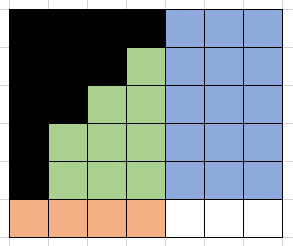
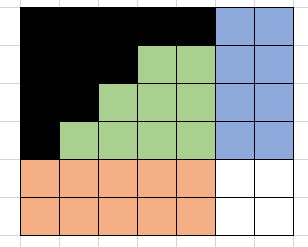
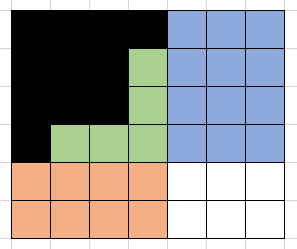
可以转移到的状态
注意到,一旦第一行或第一列完成填充,那么将不会再产生新的位置,或者换一句话说,所有位置都将变成可选位置,所以对于dp[n][j][z]或dp[i][m][z]而言,要考虑它能产生的方案数,其实就是它还剩下的位置数的阶乘。
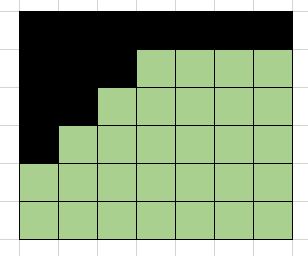

剩下的位置可以以任意顺序填充
所以有:
dp[n][j][z]=(n*m-n-j+1-z)!
dp[i][m][z]=(n*m-i-m+1-z)!
从dp[n-1][m-1]开始,反向递推就能求出dp[1][1][0]
假设已经给n*m安排了一个位置,那么n*m-1就是剩下的数中最大的,但是他的安放收到限制,不能再让他同时满足行列最大。观察发现,它只有在n*m同行或同列时,它才不是这行或这一列最大的,也就是说n*m-1必须和n*m同行或同列。接下来n*m-2也是同理,必须和n*m或n*m-1其中一个同行或同列。
因此,为了构造合法的矩阵,优先考虑的是当前最大的数,所以应该按照从大到小的顺序来填充。只要保证每个数都与之前的数中的某一个同行同列,那么构造出来的所有矩阵都是合法的。
如果换个角度来看问题就是这样,每次操作都有若干个位置可以选择,而每次给一个数安排一个位置,就相当于把所在的行和列,加入到下一个数的可选位置中。
容易发现,如果选择的位置所在行已经被添加过,那么可选位置只会增加列;如果所在列已经被添加过,那么只增加行;如果都被添加过了,那么这次安排就不会产生新的位置。根据增加的情况不同,可以把矩形划分成若干个区域,在某个区域中的任意位置安放数,增加的个数都是相同的。 为了方便分析,因为在同一区域中安放对最后求方案个数没有影响,可以规定每次只能选择区域左上角的位置。
比如说,第一个数有n*m种选择,但只考虑把它放到(1,1),然后把第一行和第一列加入到可选择的位置;

第二个数有n+m-1种选择,它可以放到与(1,1)相邻的(1,2),或(2,1)
 或
或 
后面的数以此类推

比较一般的情况:

接下来的问题就是,需要维护的只有三个区域,观察发现,可以用三个指标来表示当前的状态:绿色区域的右下角的坐标(同时也是蓝色区域的左下角,橙色区域的右上角),以及已经在绿色区域填入了多少个数(用绿色区域的大小也能表示当前状态,但前者在状态转移的时候更为直观)。
对于(i, j, z)来说,下一个位置可以填在蓝色区域,橙色区域,绿色区域,对应能转移到的状态就是(i+1, j, z),(i, j+1, z),和(i, j, z+1),其中,蓝色区域的大小为i*(m-j),橙色区域的大小为j*(n-i),绿色区域的大小为(i-1)*(j-1)-z,因此,如果用dp[i][j][z]记录(i, j, z)能产生的方案个数,那么就有dp[i][j][z]= i*(m-j)*dp[i+1][j][z] + j*(n-i)*dp[i][j+1][z]+ ((i-1)*(j-1)-z)*dp[i][j][z+1];



注意到,一旦第一行或第一列完成填充,那么将不会再产生新的位置,或者换一句话说,所有位置都将变成可选位置,所以对于dp[n][j][z]或dp[i][m][z]而言,要考虑它能产生的方案数,其实就是它还剩下的位置数的阶乘。


dp[n][j][z]=(n*m-n-j+1-z)!
dp[i][m][z]=(n*m-i-m+1-z)!
从dp[n-1][m-1]开始,反向递推就能求出dp[1][1][0]
总结
本来最开始的时候,觉得数据量不大可以用dfs搜索一下的,后来发现搜索的时候有很多相同的状态,只要i, j, z都一样,那方案数就是一样的,于是加入记忆化搜索。后来写着,怎么觉得越看越像以前看过的推dp的样子,于是终于想到要用dp来做了。公式本身不算复杂,但是问题比较抽象,需要转化一下才好理解。
代码
#include<stdio.h> #include<memory.h> typedef long long LL; int n, m; LL mod; int fac[10004];//阶乘打表 int dp[90][90][90 * 90];//已经处理到n行 m列 重叠部分填了z个 LL help; void init() { memset(dp, 0, sizeof dp); fac[0] = 1; fac[1] = 1; //因为取模每次都在变,所以每次都要打表 for (int t = 2; t <= 10000; t++) { help = LL(t)*fac[t - 1] % mod; fac[t] = help % mod; } //第一列全满的情况 for (int j = 1; j <= m; ++j) { for (int z = 0; z <= (n-1)*(j-1); ++z) dp[n][j][z] = fac[n*m-n-j+1 - z]; } //第一行全满的情况 for (int i = 1; i <= n; ++i) { for (int z = 0; z <=(m-1)* ( i - 1); ++z) dp[i][m][z] = fac[n*m-i-m+1 - z]; } //从dp[n-1][m-1]逆序递推 for (int i = n - 1; i >= 1; --i) { for (int j = m - 1; j >= 1; --j) { for (int z = (i - 1)*(j - 1); z >= 0; --z) { help = LL(n-i)*(j)*dp[i + 1][j][z] /*下*/+ LL(m-j)*(i)*dp[i][j + 1][z] /*右*/+ LL((i-1)*(j-1)-z)*dp[i][j][z + 1] /*内*/; dp[i][j][z] = help % mod; } } } } int main() { int kase; for (scanf("%d", &kase); kase; kase--) { scanf("%d %d %lld", &n, &m, &mod); init(); help = LL(n)*m*dp[1][1][0]; int ans = help%mod; printf("%d ", ans); } }